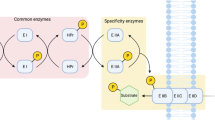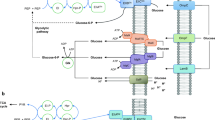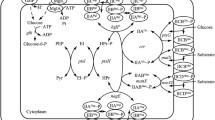Abstract
As a member of the saccharolytic clostridia, a variety of different carbohydrates like glucose, fructose, or mannose can be used as carbon and energy source by Clostridium acetobutylicum ATCC 824. Thirteen phosphoenolpyruvate-dependent phosphotransferase systems (PTS) have been identified in C. acetobutylicum, which are likely to be responsible for the uptake of hexoses, hexitols, or disaccharides. Here, we focus on three PTS which are expected to be involved in the uptake of fructose, PTSFru, PTSManI, and PTSManII. To analyze their individual functions, each PTS was inactivated via homologous recombination or insertional mutagenesis. Standardized comparative batch fermentations in a synthetic medium with glucose, fructose, or mannose as sole carbon source identified PTSFru as primary uptake system for fructose, whereas growth with fructose was not impaired in PTSManI and slightly altered in PTSManII-deficient strains of C. acetobutylicum. The inactivation of PTSManI resulted in slower growth on mannose whereas the loss of PTSManII revealed no phenotype during growth on mannose. This is the first time that it has been shown that PTSFru and PTSManI of C. acetobutylicum are directly involved in fructose and mannose uptake, respectively. Moreover, comprehensive comparison of the fermentation products revealed that the loss of PTSFru prevents the solvent shift as no butanol and only basic levels of acetone and ethanol could be determined.






Similar content being viewed by others
References
Abranches J, Chen YY, Burne RA (2003) Characterization of Streptococcus mutans strains deficient in EIIAB Man of the sugar phosphotransferase system. Appl Environ Microbiol 69:4760–4769
Behrens S, Mitchell WJ, Bahl H (2001) Molecular analysis of the mannitol operon of Clostridium acetobutylicum encoding a phosphotransferase system and a putative PTS-modulated regulator. Microbiology 147:75–86
Benthin S, Nielsen J, Villadsen J (1993) Two uptake systems for fructose in Lactococcus lactis subsp. cremoris FD1 produce glycolytic and gluconeogenic fructose phosphates and induce oscillations of growth and lactic acid formation. Appl Environ Microbiol 59:3206–3211
Ferenci T, Kornberg HL (1971a) Pathway of fructose utilization by Escherichia coli. FEBS Lett 13:127–130
Ferenci T, Kornberg HL (1971b) Role of fructose-l,6-diphosphatase in fructose utilization by Escherichia coli. FEBS Lett 14:360–363
Fischer RJ, Oehmcke S, Meyer U, Mix M, Schwarz K, Fiedler T, Bahl H (2006) Transcription of the pst operon of Clostridium acetobutylicum is dependent on phosphate concentration and pH. J Bacteriol 188:5469–5478
Fond O, Petitdemange E, Petitdemange H, Gay R (1984) Effect of glucose flow on the acetone butanol fermentation in fed batch culture. Biotechnol Lett 6:13–18
Gay P, Cordier P, Marquet M, Delobbe A (1973) Carbohydrate metabolism and transport in Bacillus subtilis. Mol Gen Genet 121:355–368
Girbal L, von Abendroth G, Winkler M, Benton PM, Meynial-Salles I, Croux C, Peters JW, Happe T, Soucaille P (2005) Homologous and heterologous over-expression in Clostridium acetobutylicum and characterization of purified clostridial and algal Fe-only hydrogenases with high specific activities. Appl Environ Microbiol 71:2777–2781
Görke B, Stülke J (2008) Carbon catabolite repression in bacteria: many ways to make most out of nutrients. Nature Rev Microbiol 6:613–616
Hanahan D (1983) Studies on transformation of Escherichia coli with plasmids. J Mol Biol 166:557–580
Heap JT, Pennington OJ, Cartman ST, Carter GP, Minton NP (2007) The ClosTron: a universal gene knock-out system for the genus Clostridium. J Microbiol Meth 70:452–464
Heap JT, Kuehne SA, Ehsaan M, Cartman ST, Cooksley CM, Scott JC, Minton NP (2010) The ClosTron: mutagenesis in Clostridium refined and streamlined. J Microbiol Methods 80:49–55
Hillmann F, Fischer RJ, Saint-Prix F, Girbal L, Bahl H (2008) PerR acts as a switch for oxygen tolerance in the strict anaerobe Clostridium acetobutylicum. Mol Microbiol 68:848–860
Hugo HV, Gottschalk G (1974) Distribution of 1-phosphofructokinase and PEP:fructose phosphotransferase activity in clostridia. FEBS Lett 46:106–108
Hutkins RE, Kashket ER (1986) Phosphotransferase activity in Clostridium acetobutylicum from acidogenic and solventogenic phases of growth. Appl Environ Microbiol 51:1121–1123
Jones DT, Woods DR (1986) Acetone-butanol fermentation revisited. Microbiol Rev 50:484–524
Kornberg HL (2001) Routes for fructose utilization by Escherichia coli. J Mol Microbiol Biotechnol 3(3):355–359
Kotrba P, Inui M, Yukawa H (2001) Bacterial phosphotransferase system (PTS) in carbohydrate uptake and control of carbon metabolism. J Biosci Bioeng 92:502–517
Lehmann D, Lütke-Eversloh T (2011) Switching Clostridium acetobutylicum to an ethanol producer by disruption of the butyrate/ butanol fermentative pathway. Metab Eng 13:464–473
López-Contreras AM, Martens AA, Szijarto N, Mooibroek H, Claassen PAM, van der Oost J, de Vos WM (2003) Production by Clostridium acetobutylicum ATCC 824 of CelG, a cellulosomal glycoside hydrolase from family 9. Appl Environ Microbiol 69:869–877
McDonald JH (2009) Handbook of biological statistics, 2nd edn. Sparky House Publishing, Baltimore, Maryland
Mermelstein LD, Papoutsakis ET (1993) In vivo methylation in Escherichia coli by Bacillus subtilis Phage 3 T I methyltransferase to protect plasmids from restriction upon transformation of Clostridium acetobutylicum ATCC 824. Appl Environ Microbiol 59:1077–1081
Meyer CL, Papoutsakis ET (1989) Increased levels of ATP and NADH are associated with increased solvent production in continuous cultures of Clostridium acetobutylicum. Appl Microbiol Biotechnol 30:450–459
Mitchell WJ (1996) Carbohydrate uptake and utilization by Clostridium beijerinckii NCIMB 8052. Anaerobe 2:379–384
Mitchell WJ, Tangney M (2005) Carbohydrate uptake by the phosphotransferase system and other mechanisms. In: Dürre P (ed) Handbook on Clostridia. CRC Press, Boca Raton, pp 155–176
Monot F, Martin JR, Petitdemange H, Gay R (1982) Acetone und butanol production by Clostridium acetobutylicum in a synthetic medium. Appl Env Microbiol 44:1318–1324
Nölling J, Breton G, Omelchenko MV, Makarova KS, Zeng Q, Gibson R, Mei Lee H, Dubois J, Qiu D, Hitti J, Wolf YI, Tatusov RL, Sabathe F, Doucette-Stamm L, Soucaille P, Daly MJ, Bennett GN, Koonin EV, Smith DR (2001) Genome sequence and comparative analysis of the solvent-producing bacterium Clostridium acetobutylicum. J Bacteriol 183:4823–4838
Postma PW, Lengeler JW, Jacobson GR (1993) Phosphoenolpyruvate: carbohydrate phosphotransferase systems of bacteria. Microbiol Rev 57:543–594
Roos JW, McLaughlin JK, Papoutsakis ET (1985) The effect of pH on nitrogen supply, cell lysis, and solvent production in fermentations of Clostridium acetobutylicum. Biotechnol Bioeng 27:681–694
Saier MH Jr, Tseng TT (1999) Evolutionary origins of transmembrane transport systems. In: Broome-Smith JK (ed) Transport of molecules across microbial membranes. University Press, Cambridge, p 252
Sambrook J, Russell DW (2001) Molecular cloning: a laboratory Manual, 3rd edn. Cold Spring Harbor Laboratory Press, Cold Spring Harbor, N. Y., USA
Schmidt TG, Skerra A (2007) The Strep-tag system for one-step purification and high-affinity detection or capturing of proteins. Nat Protoc 2:1528–1535
Servinsky MD, Kiel JT, Dupuy NF, Sund CJ (2010) Transcriptional analysis of differential carbohydrate utilization by Clostridium acetobutylicum. Microbiology 156:3478–3491
Soucaille P, Figge R, Croux C (2006) Process for chromosomal integration and DNA sequence replacement in Clostridia. Dépôt PCT no PCT/EP2006/066997
Stülke J, Hillen W (1998) Coupling physiology and gene regulation in bacteria: the phosphotransferase sugar uptake system delivers the signals. Naturwissenschaften 85(12):583–592
Tangney M, Mitchell WJ (2007) Characterisation of a glucose phosphotransferase system in Clostridium acetobutylicum ATCC 824. Appl Microbiol Biotechnol 74:398–405
Wietzke M, Bahl H (2012) The redox-sensing protein Rex, a transcriptional regulator of solventogenesis in Clostridium acetobutylicum. Appl Microbiol Biotechnol 96:749–761
Acknowledgments
We are grateful to Nigel P. Minton and John T. Heap, University of Nottingham (UK) for kindly providing the ClosTron® plasmids, Philippe Soucaille, INSA (Toulouse, France) for kindly providing the pCons::upp, and Mandy Wietzke (University of Rostock) for providing pT-catP::hydA. This work was supported in parts by the German Federal Ministry of Education and Research (BMBF) through the SysMO project COSMIC2 (0315872D).
Author information
Authors and Affiliations
Corresponding author
Rights and permissions
About this article
Cite this article
Voigt, C., Bahl, H. & Fischer, RJ. Identification of PTSFru as the major fructose uptake system of Clostridium acetobutylicum . Appl Microbiol Biotechnol 98, 7161–7172 (2014). https://doi.org/10.1007/s00253-014-5809-1
Received:
Revised:
Accepted:
Published:
Issue Date:
DOI: https://doi.org/10.1007/s00253-014-5809-1




